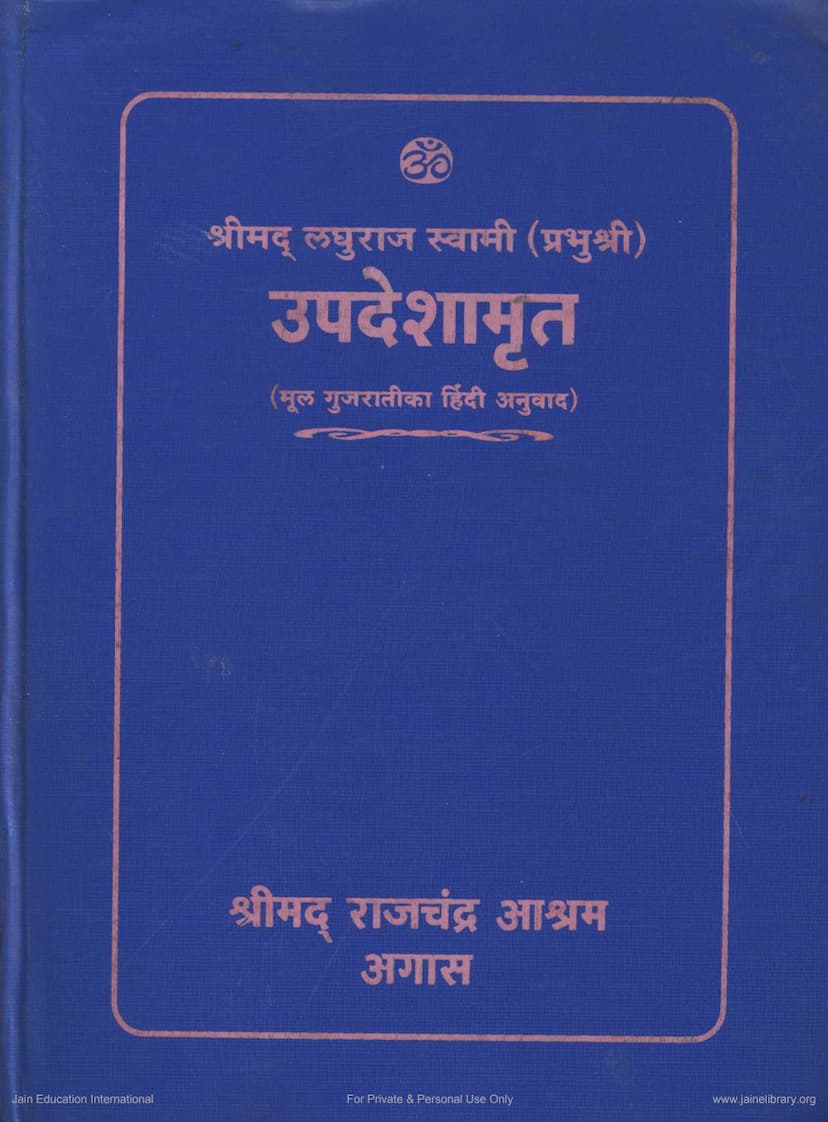Updeshamrut
Added to library: September 2, 2025

Summary
Here's a comprehensive summary of the provided Jain text, "Updeshamrut," based on the text you've supplied:
Book Title: Updeshamrut (The Nectar of Precepts) Author: Shrimad Laghuraj Swami (Prabhushri) Publisher: Shrimad Rajchandra Ashram, Agas Catalog Link: https://jainqq.org/explore/001941/1
Overall Essence:
"Updeshamrut" is a collection of spiritual teachings and guidance, primarily presented in Hindi (translated from Gujarati), attributed to Shrimad Laghuraj Swami (Prabhushri). The text emphasizes the profound importance of a spiritual guide (Sadguru) and the soul's journey towards self-realization and liberation. It highlights the teachings of Shrimad Rajchandra, portraying him as a divine soul who revealed the path to the highest spiritual peace. The compilation is presented as a memorial work, released on the centenary of Shrimad Laghuraj Swami's birth.
Key Themes and Teachings:
-
The Supremacy of the Sadguru: A recurring and central theme is that true spiritual understanding and liberation can only be attained through the grace and guidance of a living, self-realized Guru (Sadguru). The text quotes Shrimad Rajchandra emphasizing that one should only listen to, contemplate, and worship one whose soul is established in the self (Atmasthiti). The company of such a knowledgeable person, free from selfish motives, is the primary means to detach from worldly passions and remain steadfast in one's own true nature. The verses in the "Abhivandana" section are replete with praise and reverence for Shrimad Rajchandra as the divine Guru.
-
The Nature of the Soul (Atma): The teachings consistently point towards understanding the true nature of the soul. The soul is described as an eternal, unchanging, pure consciousness, distinct from the physical body and worldly experiences. While the soul is the ultimate treasure, worldly distractions and self-indulgence prevent one from recognizing this innate divinity. The goal is to turn inward, attain self-realization, and reside eternally in the blissful abode of the soul.
-
The Path to Liberation: The book stresses that mere external rituals or diverse austerities performed without understanding the true nature of the soul are insufficient for liberation. True liberation comes from realizing the soul's true nature, which is facilitated by the Sadguru's grace. The teachings advocate for detachment from worldly pleasures and passions, controlling the senses, and focusing the mind inward.
-
The Importance of Right Perspective (Samyak Drishti): A crucial aspect is the necessity of right perspective. The text suggests that a distorted worldview (mithyatva) leads to suffering and delusion. Correcting this perspective, understanding the transient nature of the world and the permanence of the soul, is paramount. The teachings often emphasize looking beyond the superficial and recognizing the soul as the true reality.
-
The Role of Devotion (Bhakti): While emphasizing self-effort through knowledge and meditation, the text also highlights the power of devotion. "Parabhakti" (supreme devotion) is described as the ultimate stage where the individual soul merges with the divine. This is achieved through unwavering devotion to the realized Guru, who is seen as an embodiment of the divine.
-
Practical Guidance and Disciplines: The "Pravachan" sections and "Patalis" (Letters) offer practical advice. These include:
- Abandoning Vices: Renouncing the seven deadly sins and abstaining from forbidden foods (like root vegetables).
- Right Conduct: Speaking truthfully, practicing non-violence, and controlling desires.
- Contemplation and Remembrance: Regularly reflecting on the soul's nature and remembering the Guru's teachings.
- Detachment: Cultivating indifference towards worldly possessions, relationships, and experiences, recognizing their impermanent nature.
- Unity and Equanimity: Treating all beings with equanimity and seeing the divine in everyone.
-
Overcoming Obstacles: The teachings acknowledge the challenges in the spiritual path, such as the mind's restlessness, the influence of passions (kashayas), external distractions, and the illusion of worldly pleasures. The guidance provided is to overcome these through steadfast devotion to the Guru, consistent practice, and unwavering faith.
-
The Guru's Life and Teachings: The biographical account of Shrimad Laghuraj Swami's life (from his birth in Vatamana to his passing at the Agas Ashram) is interwoven with his spiritual discourses. It details his interactions with Shrimad Rajchandra, his spiritual journey, his acceptance of monastic vows, and his dedicated service to propagating the spiritual path. The letters ("Patalis") offer direct insights into his spiritual understanding and his interactions with disciples and other spiritual figures.
-
The Nature of Suffering and Liberation: The text repeatedly refers to the inherent suffering in the cycle of birth and death (samsara) and the ultimate goal of achieving liberation (moksha) from this cycle. Suffering arises from ignorance of the soul's true nature and attachment to the transient material world. Liberation is attained by eradicating ignorance and attachment, leading to the soul's realization and eternal bliss.
-
The Importance of Effort and Faith: While the Guru's grace is essential, the text also underscores the individual's role in making sincere efforts. This includes consistent practice, unwavering faith in the Guru's teachings, and a genuine desire for spiritual upliftment. The collection of his discourses is seen as a powerful guide for those seeking spiritual advancement.
Structure of the Book:
The book is structured into several sections:
- Life History: A detailed biography of Shrimad Laghuraj Swami.
- Patalis (Letters): A collection of letters written by or on behalf of Shrimad Laghuraj Swami, offering direct spiritual counsel. These are divided into two parts, reflecting different origins or compilations.
- Vicharana (Reflections): Shrimad Laghuraj Swami's own reflections on spiritual matters.
- Updesh Sangrah (Collection of Discourses): A compilation of his discourses and teachings, categorized into six parts, capturing the essence of his spiritual guidance.
- Miscellaneous Sayings: Some scattered verses and sayings.
- Appendices: Providing further information, indexes, and clarifications for the reader's study.
In essence, "Updeshamrut" serves as a spiritual manual, guiding the seeker towards self-discovery and ultimate liberation by emphasizing the transformative power of the Guru's teachings and the unwavering pursuit of spiritual truth.